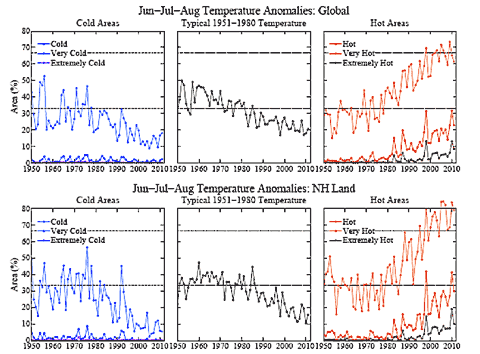 James Hansen and two fellow-authors have circulated a new paper which they will be submitting for publication, Perceptions of Climate Change: The New Climate Dice. I’m not qualified to comment on its scientific detail beyond reporting it as relatively accessible to the lay person, but there were elements in the discussion with which it concluded that I thought I could dwell on as a member of the general public with whom Hansen is always concerned to communicate.
James Hansen and two fellow-authors have circulated a new paper which they will be submitting for publication, Perceptions of Climate Change: The New Climate Dice. I’m not qualified to comment on its scientific detail beyond reporting it as relatively accessible to the lay person, but there were elements in the discussion with which it concluded that I thought I could dwell on as a member of the general public with whom Hansen is always concerned to communicate.
The paper deals with the increasing frequency of extreme summer heat such as that experienced in the Moscow region in 2010 and Texas in 2011 and reaches the conclusion that we can say with a high degree of confidence that such events were a consequence of global warming. The base period of 1951 to 1980 is chosen against which to compare the changes of the last three decades. The chance of what would have been regarded as “hot” summers during that base period has increased in more recent decades and is now about 80%. Hansen comments that the climate dice are now loaded to the degree that a perceptive person (old enough to remember the climate of 1951 to 1980) should recognise the existence of climate change. I’m old enough. That base period coincides with the first half of my adult life.
Unfortunately my climate memory (or any memory for that matter) has deteriorated with age and I can’t honestly say that I recognise the change. But I can certainly see from the maps and graphs the paper provides that the second half of my adult years has been spent in a global climate significantly changed and continuing to change. It’s a sobering thought, bringing home the magnitude and rapidity of the alteration we have effected.
Hansen’s defence of the choice of 1951-1980 as a base period makes good sense. It is the earliest period with good global coverage of meteorological stations. It is also more representative of the climate to which life on Earth is adapted during the more than ten thousand years of the Holocene than are the more recent decades. The most recent few decades must be warmer than prior Holocene levels, “given the fact that the major ice sheets in both hemispheres are presently losing mass rapidly and global sea level is rising at a rate of more than 3 m/millennium, much greater than at any time in the past several thousand years”. A base period closer to our present time, such as the three decades prior to the present decade, does not enable the public to appreciate the full extent of the climate variability which has been developing since 1980.

Hansen’s Figure 5 shows the marked increase in NH summers that are very hot or extremely hot over the last 60 years.
The paper refers to meteorological explanations of extreme heat events, for example that the Moscow heat wave was caused by an atmospheric “blocking” situation, or the Texas heat wave was caused by La Niña ocean temperature patterns. It grants that the locations of the extreme anomalies in any given case are related to specific weather patterns. However it points out that blocking patterns and La Niñas have always been common, yet the large areas of extreme warming have come into existence only with large global warming. It is the simultaneous contribution of global warming to specific weather patterns which results in the extreme anomalies.
The paper comments that at the other end of the hydrologic cycle unusually heavy rainfall and record floods are also amplified by global warming since the amount of water vapour that the atmosphere holds increases with atmospheric temperature. What were “100-year” or “500-year” events are expected to occur more frequently. Rainfall data reveal significant increases of heavy precipitation over much of Northern Hemisphere land and in the tropics, an intensification which studies link to human-caused global warming.
Finally mention is made of the effect of the rapid monotonic global trend of the last three decades on natural ecosystems adapted to the stable climate of the Holocene. It is well recognised that warmer winters have led to an epidemic of pine bark beetles and widespread destruction of forests in Canada and the western United States. Hansen tosses in his own anecdotal experience of stress on a number of tree species on his property in eastern Pennsylvania. The species have existed in the region for millennia and he ruminates that it is implausible that Native Americans had to water birch trees to keep them alive as is the case at present during anomalously hot summers.
Animals, birds and insects are also suffering noticeable effects. Continued climate shift at the rate of the past three decades is expected to take an enormous toll on planetary life with 20-50 percent of the species on Earth committed to extinction if global warming approaches 3 degrees by the end of the century.
It doesn’t have to happen, Hansen adds before concluding. A fast transition to a clean energy future could limit further global warming to several tenths of a degree. We could still preserve life as we know it.
It’s not difficult to get a handle on what climate scientists are saying with what Hansen describes as a high degree of confidence in the reliability of their observations. There isn’t an MP or a CEO or a journalist in the country who couldn’t understand what Hansen and myriad other climate scientists are explaining. For that matter the majority of the population at large are perfectly capable of grasping the essential picture. There may be a psychological block to crediting that it is all happening so rapidly and that we are literally creating a different and much less friendly global environment, but there’s no intellectual impediment.
I admit to being staggered by the speed of what we would normally think of as happening over vast stretches of time, but there’s no point arguing with the reality that is becoming apparent. There is, however, every point in mobilising for the urgent transition to a clean energy economy which Hansen considers could yet pull us back to more manageable temperature rise.

“Unfortunately my climate memory”
One enduring memory I have of going to school in the 1970’s in the Far North is how cold winter was. We’d walk to school on frosty days and puddles would be frozen over. The that was a regular enough occurrence. It just doesn’t happen anymore (the frozen puddles that is, not going to school!) and I live not far from where I grew up. In fact we barely have frosts at all now.
Apart from obvious indications like that, you’re right, the ol’ climate memory is notoriously unreliable.
A good discussion of the practical implications of the paper is here:
http://earlywarn.blogspot.com/2012/01/lots-more-killer-summers-on-way.html
Staniford concludes that if the projected trend continues:
“we are looking at the average summer being almost a “+2” on the 1951-1980 scale. And the “+3” “hotter than living memory” type events will be occurring around 1 year in 4 or so. And “+4” and “+5” events that would have been completely inconceivable will be happening often enough to notice – you’ll likely experience a “+4” summer for your climate and, at a minimum, you’ll be reading about the “+5″ events in the news if you are lucky enough not to experience one.”